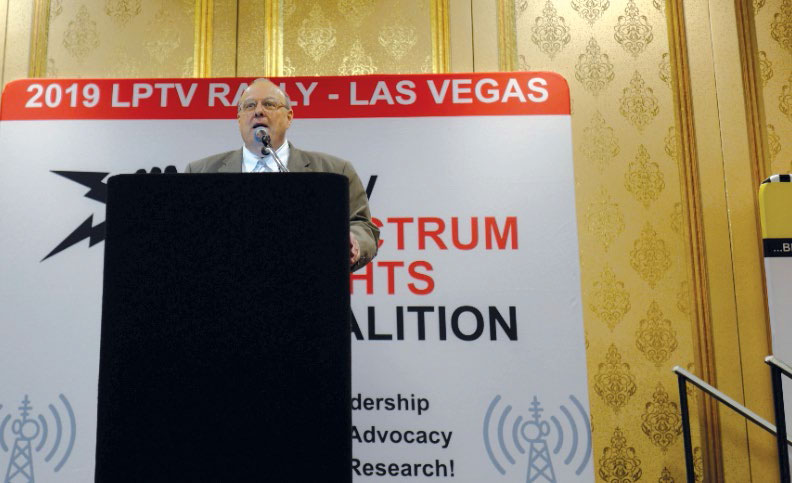LPTVs Wait for Repack Funds, Eye ATSC 3.0
ALEXANDRIA, VA.—Money is on the minds of America’s low-power TV station owners these days.

With the FCC announcing last month that it is now taking applications for repack reimbursement funds from the TV Broadcasters TV Relocation fund, LPTVs who have paid heavily to switch frequencies under the FCC’s spectrum repack are anxiously awaiting the check in the mail. These LPTVs and others are also looking to ATSC 3.0 and the opportunities it might bring to their broadcast sector—and some believe that these opportunities are huge.
MIXED FEELINGS
Many LPTVs are having to change channels under the spectrum repack; a process that is compelling them to invest heavily in new/rebuilt transmission infrastructure.
In some cases, changing channels can leave the LPTVs with poorer coverage than they had before. Such is the case for Mike Tonges, owner of the northwestern Ohio LPTVs WIVM39 (Canton), WIVX13, WIVD22, WIVN29, and W27DG-D 27.
Tonges started with WIVM in 2001, which eventually moved to Canton. Today, due to the twists-and-turns of the spectrum auction and the resulting repack, his expenses have piled up while his LPTVs’ coverage area has degraded.
“Our original Canton, Ohio Channel 39 had a very good omnidirectional signal covering our area,” said Tonges. “Now with all five of our stations combined on VHF channels and crowded UHF channels, we will barely have our previous footprint.”
Get the TV Tech Newsletter
The professional video industry's #1 source for news, trends and product and tech information. Sign up below.
Meanwhile, “we currently are bearing the cost of displacement due to the spectrum auction completely on our own,” said Dean Marini, general manager of Tonges’ five LPTVs. “While reimbursement is promised—and a plan announced—we’re not sure when that money will be given or exactly how much, so we need to do what we can to get the stations onto their new channels as cost-effectively as possible. I would suspect the majority of low-power owners are in the same situation.”
The FCC announced a 60-day filing window for $150 million in LPTV relocation funding on August 15. “Once all of the filing and qualification forms have been submitted, the FCC will first qualify them [prove they were on the air nine of 12 months before the auction started], and then see how much of the $150 million has been asked for,” said Mike Gravino, director of the LPTV Spectrum Rights Coalition. “Actual release of the funds could start in later Q1 2020 or Q2. There will be about 1,500 [or less] LPTV and translators which may qualify for the funds, so the average will be about $100K, but will widely vary depending on each unique relocation situation.”
Other LPTVs have had an easier time—for instance, Meredith Local Media Group owns WHSM-LD, a Class A LPTV in Springfield, Mass., which has to move from Channel 21 to 20 due to the repack. But WHSM hasn’t had to move yet, because “there is another channel that was going to displace us has elected to go dark for now,” said Tom Casey, Meredith’s vice president of engineering and technology. “So we haven’t made the transition to date.”

Univision Communications owns 14 Class As; nine of which have been affected by the spectrum repack. But the move, which cost Univision $600,000, “has actually been positive,” said John Buergler, the company’s senior vice president of Growth Initiatives/Local Media.
“This is because a lot of our Class As are redundant, and can be used for other purposes,” he said. “For instance, we already have two full-power stations in Dallas, So we moved our Class A transmission site to a new location and increased the power, so that we now cover the core of Fort Worth/Dallas/Arlington. This has turned into an economically viable asset that we can use.”
OPPORTUNITIES IN NEXT GEN TV
ATSC 3.0—which combines broadcast and IP—offers data-carriage capabilities that excite many LPTV owners, who believe the new standard offers them real money-making opportunities.
The reason many LPTVs believe this has to do with the law, according to Gravino. “Unlike full-power TV broadcasters, LPTVs don’t have to simulcast in ATSC 1.0 when they turn on ATSC 3.0 services,” he said. “We can cut to 3.0 right away, and lease whatever bandwidth we don’t use for broadcasting content, to transmit data on behalf of third-party customers.”
For LPTV owners, the true datacasting potential of ATSC 3.0 occurs when they combine their LPTV channels together into big swaths of bandwidth. This approach allows them to maintain HDTV service while creating multi-megabit channels for paid third-party carriage. “The question right now is what’s the business model?” Gravino mused. “How will it work?”
One possible money-maker: Providing software updates to today’s cars and trucks. “Today’s vehicles are basically huge computers,” said Dave Folsom, retired CTO of Raycom Media and now a consultant with the Pearl TV Group. “They need updates on a regular basis. It would be far more cost-effective for manufacturers to send these updates via ATSC 3.0 with its one-to-many reach, compared to using one-to-one on 4G cellular or taking the vehicles into dealerships.”
Cars and trucks aren’t alone in requiring software updates. Computer-controlled systems in the emerging world of IOT (internet of things) can be found in all areas of business and consumer technologies, and many could use ATSC 3.0 to keep these systems up to date.
Offering paid data carriage using ATSC 3.0 appeals to Larry Morton, owner and manager of KTV Media, which operates 12 LPTVs in Arkansas.
“One of our transmission sites in northwest Arkansas has five LPTVs together, and has 18 MHz of contiguous bandwidth available, with 30 MHz of bandwidth in all,” Morton said. “At the same time, we want to wait to pick the best opportunity we can. So we’re not in a rush to try things with ATSC 3.0; we’re local broadcasters content to let the bigger players lead.”
Gregory Herman, president of WatchTV, which owns/operates LPTV KOXO-CD on Channel 20 in Portland, Ore., is bullish about ATSC 3.0’s paid datacasting possibilities and is one of the reasons why WatchTV applied and received the first ATSC 3.0 LPTV license in the United States last spring.
At the same time, Herman sees ATSC 3.0 as being not only “the best digital broadcast standard to date,” but one that “eliminates the coverage issues experienced by conventional LPTVs, which gave full-power stations an advantage,” he said. “With 3.0, the playing field is level, both for broadcasting and datacasting.”
If these LPTV ATSC 3.0 advocates are correct, this new standard could be the break they’ve been waiting for since the FCC started licensing LPTVs in 1982. In the meantime, these same stations are waiting for repack reimbursement checks to arrive from Washington, so that they can get ready for the next stage of broadcast television.
For more news and insight on the repack, visit TV Technology'srepack silo.
For a comprehensive source of TV Technology’s ATSC 3.0 coverage, see ourATSC3 silo.
James Careless is an award-winning journalist who has written for TV Technology since the 1990s. He has covered HDTV from the days of the six competing HDTV formats that led to the 1993 Grand Alliance, and onwards through ATSC 3.0 and OTT. He also writes for Radio World, along with other publications in aerospace, defense, public safety, streaming media, plus the amusement park industry for something different.

